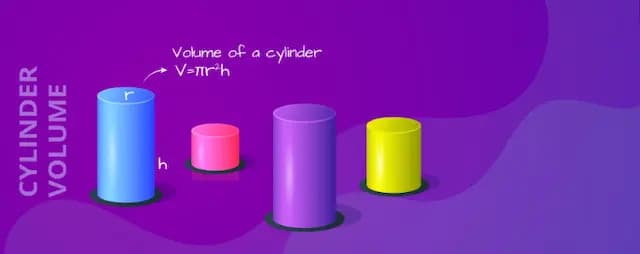
Admissions Open for

Admissions Open for
Cylinder Volume Calculator
Cylinder Volume Calculator, a user-friendly tool designed to effortlessly calculate the volume of a cylinder. Whether you're a student working on geometry problems, an engineer in need of quick calculations, or anyone curious about the volume of cylindrical objects, this calculator is here to simplify your tasks.
What is the Cylinder Volume - Calculator?
Our Cylinder Volume Calculator is an online tool that helps you determine the volume of a cylinder based on its dimensions. It is particularly useful when working with cylindrical objects, such as pipes, tanks, or any other three-dimensional structures with a circular cross-section.
What is the formula for calculating the volume of cylinder ?
The calculator employs a straightforward formula to calculate the volume of a cylinder:
Volume(V) = πr2h
where:
- V is the volume,
- π is a mathematical constant (approximately 3.14159),
- r is the radius of the cylinder's base,
- h is the height of the cylinder.
How does the Cylinder Volume - Calculator work ?
The Cylinder Volume Calculator computes the volume by multiplying the square of the cylinder's radius by its height and the mathematical constant π (pi). It utilizes the formula V = πr²h to deliver accurate volume results.
Examples
Let's calculate the volume of a cylinder with a radius (r) of 5 units and a height (h) of 10 units.
Calculation:
V = π×(5)2×10
V = π×25×10
V ≈ 785.4 Units
Let's calculate the volume of a cylinder with a radius (r) of 3.5 units and a height (h) of 8 units.
Calculation:
V = π×(3.5)2×8
V = π×12.25×8
V ≈ 307.88 Units
Let's calculate the volume of a cylinder with a radius (r) of 6 units and a height (h) of 15 units.
Calculation:
V = π×(6)2×15
V = π×36×15
V ≈ 1696.46 Units
Frequently Asked Questions
To calculate the volume of a cylinder, use the formula (V = pi r^2 h), where (V) is the volume, (pi) is approximately 3.14159, (r) is the radius of the cylinder's base, and (h) is the height.
Yes, you can use different units, but ensure consistency for accurate results. Convert one or both measurements if necessary to have matching units, such as centimeters or inches.
Yes, the value of (pi) is essential. Our calculator uses an approximation to six decimal places (3.14159) for accurate volume calculations. However, for most practical purposes, this level of precision is sufficient.
No, the formula only accepts positive values for the radius and height. Negative values would not make physical sense in the context of cylinder dimensions.
Yes, the formula is universally applicable to cylinders with a circular cross-section. Whether it's a pipe, tank, or any three-dimensional structure with a circular base, the formula remains the same.
Popular Searches
- NCERT Solutions for Class 1 subjects
- NCERT Solutions for Class 2 subjects
- NCERT Solutions for Class 3 subjects
- NCERT Solutions for Class 4 subjects
- NCERT Solutions for Class 5 subjects
- CBSE School In Aurangabad
- CBSE Schools In Bangalore
- CBSE School In Bhopal
- CBSE Schools In Chennai
- CBSE Schools In Delhi
- Best CBSE Schools In Gurgaon
- CBSE School In Hyderabad
- CBSE School In Indore
- CBSE School In Jabalpur
- CBSE Schools In Jaipur
- CBSE Schools In Kolkata
- CBSE Schools In Mumbai
- CBSE Schools In Nagpur
- CBSE Schools In Pune
- Top CBSE School In Rohtak
- Best CBSE Schools In Sonipat











